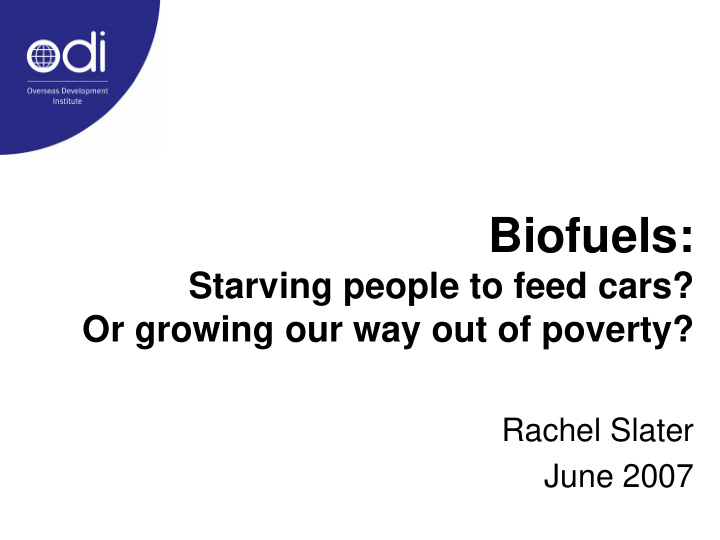



Biofuels: Starving people to feed cars? Or growing our way out of poverty? Rachel Slater June 2007
Outline • Introduction to biofuels • Links between biofuels, agriculture and poverty reduction • Links between biofuels, energy and poverty reduction • Conclusions / Contributions / Discussion
What is a biofuel? Biofuels are defined here as organic primary and/or secondary fuels derived from biomass which can be used for the generation of thermal energy by combustion or by using other technology. They comprise both purpose-grown energy crops, as well as multipurpose plantations and by-products (residues and wastes) (FAO 2000).
Types / Sources • Ethanol: - Starch (grains, roots) - Sugar (sugarcane, sugar beets, molasses) - Other biomass (wood, grass, agricultural residues, etc.) • Biodiesel: - Oilseeds (soybeans, rapeseed, sunflower) - Animal fats - Others (recycle oils “yellow grease”)
Trends in production Global Production of Fuel Ethanol Global Production of Biodiesel Fuels 35,000 2,000 1,800 30,000 1,600 M illio n liters/year Million liters/year 25,000 1,400 1,200 20,000 1,000 15,000 800 600 10,000 400 5,000 200 - - 1975 1980 1985 1990 1995 2000 2005 2010 1975 1980 1985 1990 1995 2000 2005 2010 Year Year Source: Weingart 2006
Facts and figures • The US and Brazil produce over 70% of the world’s bioethanol • The EU produces over 95% of the world’s biodiesel • 120 million litres of bioethanol are projected to be produced by 2020 • Large increases in export expected from Brazil, Indonesia and Malaysia
Opportunity for Africa? Ethanol production in Africa 2006 (%of African production) 3% 2% 5% 12% 1% Egypt 4% 5% Kenya 3% Malawi Mauritius Nigeria South Africa Swaziland Zimbabwe Other Africa 65%
Optimists • Triple solution to the problems of poverty and climate change and energy security • Local energy solutions for net energy importing countries – cheaper fuel for poor people
Pessimists • Filling the petrol tank of a range rover with ethanol requires enough grain to feed a person for one year • 10% of world’s sugar harvest converted to ethanol brought doubling of price of sugar; price of palm + 15% over last year, 25% gain expected next year • Increase in tortilla price in Mexico
Objectives / Questions • Global trends in biofuel production and consumption • Implications for future international trade and regulation • Economics of biofuel production and impacts on the agricultural sector, including adaptation costs • Possibilities for local value addition • Poverty reduction, equity dimensions and food security
Poverty reduction, equity dimensions and food security – access to, ownership and use of land by the poor; – difference between different biofuel production systems – poor people’s access to biofuel supply chains to poor people – winners and losers under different scenarios – impacts on food production and food prices
The macro position / biofuels trade • Energy importing developing countries • Biofuel-producing developing countries • Northern countries avoiding more agricultural reform • Substitution versus export: impact • Pro-poor (and pro-rural) biofuels production • Miss the opportunity and end up worse off?
Exports and prices … distributional consequences? •Increase the incomes of producers (and countries that are in net surplus) •Reduce the incomes of consumers (and countries that are net importers)
Poverty effects Effects in • Different countries (energy importers and exporters) Effects of • Different feedstocks / production systems • Downstream (transportation) costs • Existing crop production and processing • Patterns of land holding
Economics of biofuels production • Economies of scale are important • Feedstock is the largest cost of production • Biofuels production can be complementary to other agricultural production • Biofuels production requires a significant labour force
Food security: Back to Malthus? • Beyond ‘starving people to feed cars’ • Will biofuels take land from food production? • What impacts on food prices are likely? • Impacts of aid modalities?
Conclusions • Context is critical • Address challenges in agriculture
Recommend
More recommend